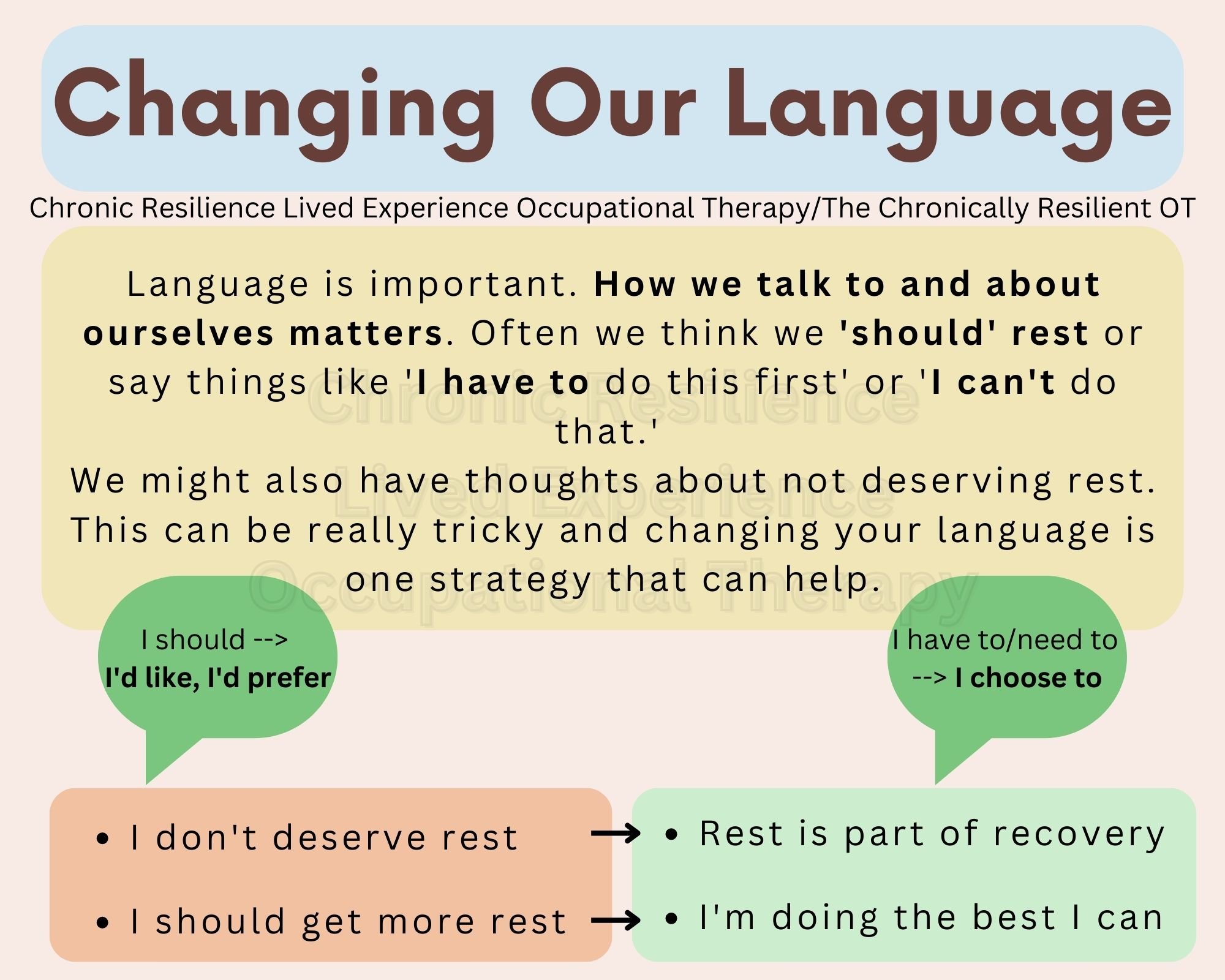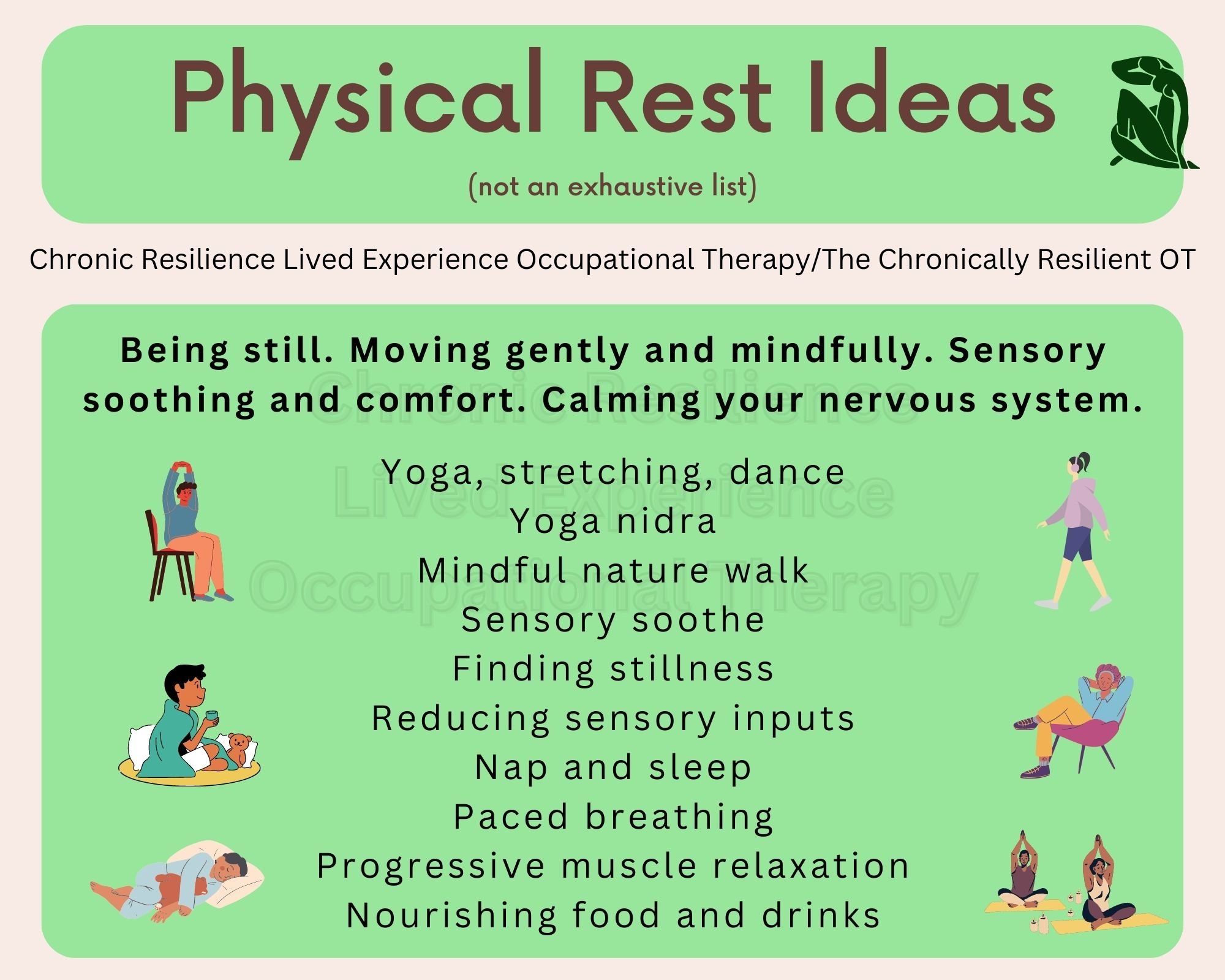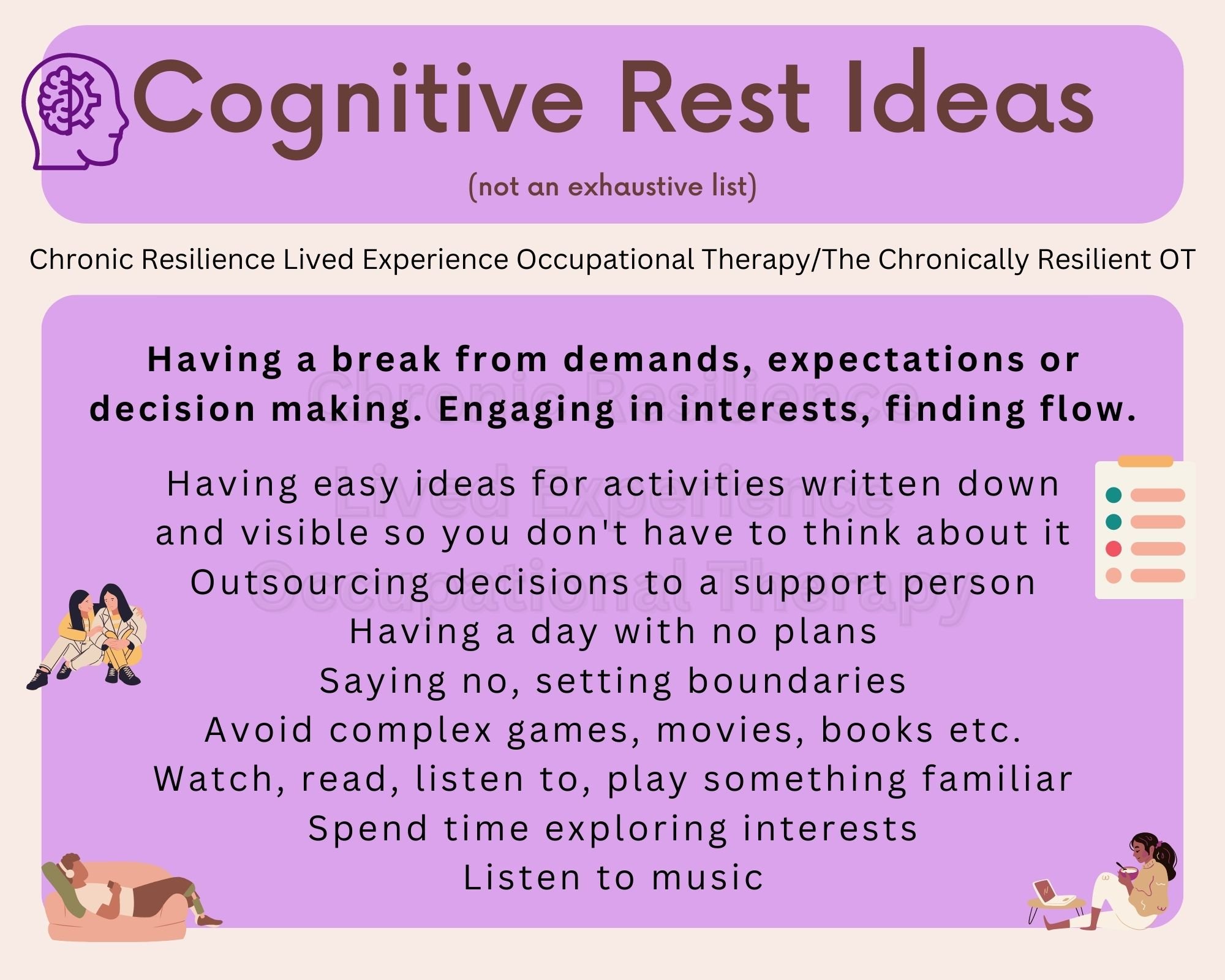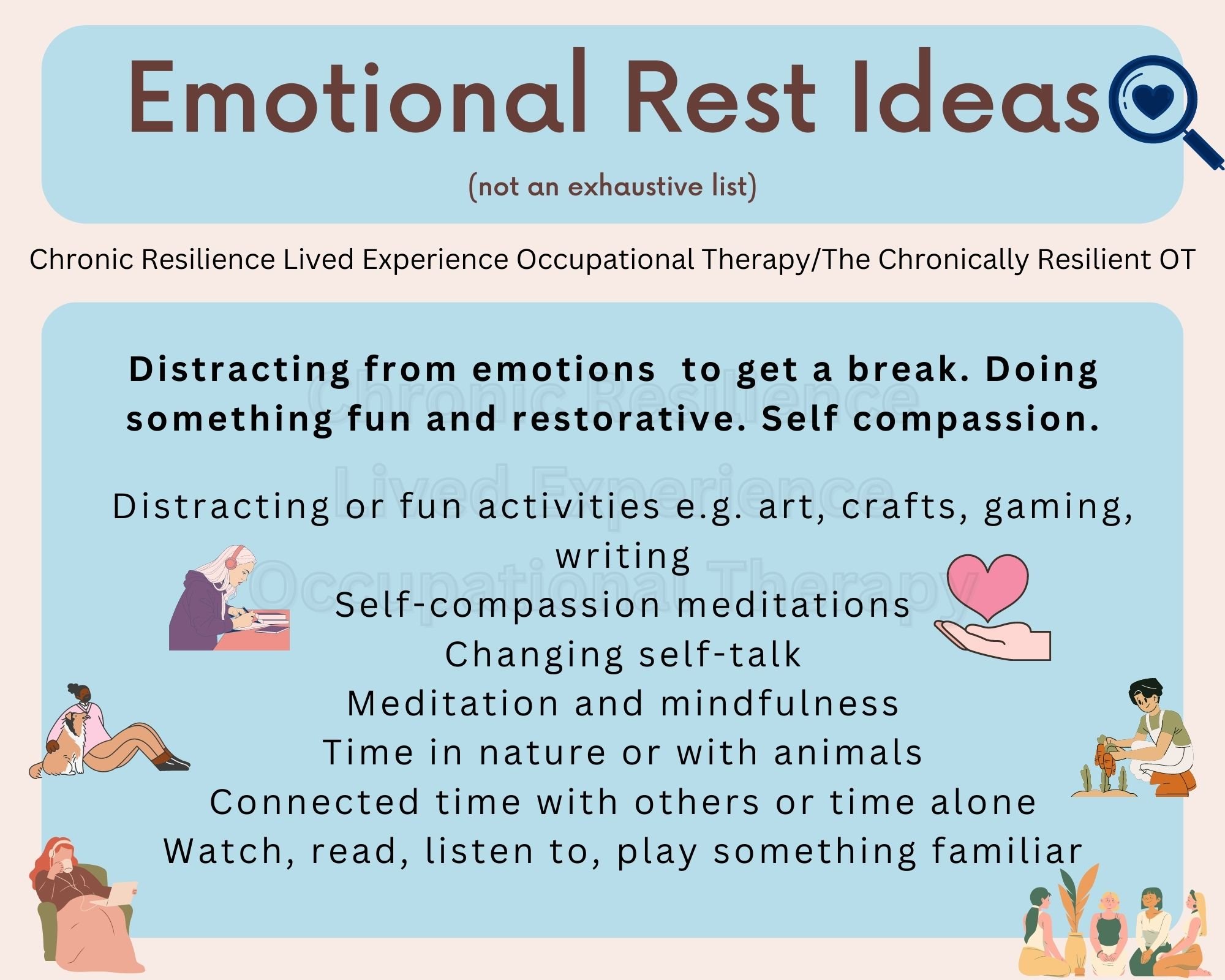Different Kinds of Rest
Image description: A Graphic with a light brown background and blue text boxes. In the top left a cartoon person is lying down with their head on a pillow. In the top right a cartoon person is sitting upside down in a chair. Heading: What is rest? Text: Rest is not just sleep. Rest is how we nourish ourselves, how we recharge, soothe and restore. It's about slowing down, taking some space, having a break. Rest is crucial for functioning. It is a necessity not a luxury. Rest is both a prevention and a management tool and is valuable in short rest snacks or in longer practices. Our systems need downtime to recharge. Everyone deserves rest. Every body needs rest. Below this is a person sitting with their legs up in a comfy chair, other words for rest are to the left and right: Stopping, Restoring, Slowing down
Having a break, Regaining strengthPeace of mind, Nourishing, Recharging, Soothing, Taking some space.
——————
Here’s a few dictionary definitions for rest:
Cambridge Dictionary - Rest:
A period of time in which you relax, do not do anything active, or sleep:
To stop being active for a period of time in order to relax and get back your strength, or to cause someone or something to stop doing an activity in order to get back strength;
At rest means not doing anything active or not moving.
Merriam-Webster Dictionary - Rest:
A bodily state characterized by minimal functional and metabolic activities
Freedom from activity or labor, a state of motionlessness or inactivity
Peace of mind or spirit
A rhythmic silence in music, a character representing such a silence, a brief pause in reading
Something used for support
Collins Dictionary - Rest:
If you rest or if you rest your body, you do not do anything active for a time.
If something is resting somewhere, or if you are resting it there, it is in a position where its weight is supported.
If you rest on or against someone or something, you lean on them so that they support the weight of your body.
Oxford English Dictionary - Rest:
A spell of inactivity after a period of work, a break.
To take rest by lying down or relaxing, and esp. by going to sleep; to lie still to refresh oneself, to lie asleep.
Variant of arrest - The act of stopping anything in its course; stoppage, stay, check.
Key words from these definitions - relax, stop, regain strength, inactivity, peace of mind or spirit, silence or pause, supported, lying down, sleep.
A little bit of research
The Rest Test (Hammond & Lewis, 2016) was a survey of people’s subjective experiences of rest with responses from 1800 people from 134 countries.
Most common words associated with rest were relaxing, peaceful/calming, comfortable, recuperative and sleep; words like worrying, challenging and annoying also came up.
Top 5 restful activities: reading; sleeping/napping; looking at, being at or being in a natural environment; spending time alone; listening to music.
More rest was associated with higher subjective wellbeing.
Things that impact rest: little spare time, illness and enforced rest, not able to switch off, irregular work hours and other commitments, shift work.
When rest is vaguely defined, it is difficult to know how what it is and how to do it. Bernhofer (2016) reviewed the concept of rest across articles from different disciplines: nursing, medicine, physical therapy, psychology and occupational therapy; and came up with the following definition:
“Rest is a human need, a beneficial state that is intentional, temporary and restorative, involving cessation, minimization, or change in physical, mental, or spiritual work, fatigue, trauma, illness or stress, which are the antecedents of rest.”
In the occupational therapy articles in the review rest was prescribed to improve life balance and physical/cognitive functioning and described as:
“Purposeful pursuit of non-activity; contributes to refreshment of body, mind and spirit; life balance and can improve physical and cognitive function”.
The reviewed articles talked about physical (body), emotional (mind) and spiritual (existential, transcendant, divine) rest. The benefits of rest were summarised as comfort; healing; restoration of body, mind and spirit; improvement in physical and associated mental strength and cognitive function; relief and restoration of cognitive and emotional stress; and life balance (Bernhofer, 2016).
Yoga nidra (yogic sleep) is a lying down guided meditation where you enter a sleep-like state, brain waves and heart rate slow. It shows promise for reducing insomnia, improving sleep, activating the parasympathetic nervous system and supporting mental health (Sharpe, et al., 2023; Summer & Singh, 2022). It can be a good way to get some restorative rest during the day, if, like me, you struggle to nap, or for getting to sleep more easily. For other people this won’t be suitable at all, as always it’s about finding what works for you.
Rest is about more than sleep
As we can see from the above definitions and research, rest is not just about sleep. Rest is how we nourish ourselves, how we recharge, soothe and restore. It's about slowing down, taking some space, having a break.
Rest is crucial for functioning. It is a necessity not a luxury. Rest is both a prevention and a management tool and is valuable in short rest snacks or in longer practices.
Our systems need downtime to recharge. Everyone deserves rest. Every body needs rest.
We have this myth of productivity in our society. That someone's value is defined by what they 'do'. People are so much more complex than that. Being is as valuable as doing. And continuing to do and push through has consequences for our health.
(I say this not to increase guilt, shame or pressure on anyone, but because I know first hand what can happen if you continue to push through. Please seek additional supports if you need to)
Different kinds of rest
Here is one way of categorising different types of rest - spiritual, physical, cognitive, emotional. I chose these four to keep it simple. There will be overlaps between these and you may have your own way of categorising rest.
Image description: A Graphic with a light brown background and different coloured text boxes. Heading: different kinds of rest, my categorisation. Spiritual rest is represented by a yellow textbox with an image of a hand with 3 flowers, text: Spiritual rest - Soothing the soul or spirit. Restoration. Connection. Finding a sense of safety and ease. Physical rest is represented by a green text box with an image of a person stretching, text: Physical rest - Being still. Moving gently and mindfully. Sensory soothing and comfort. Calming your nervous system. Cognitive rest is represented by a purple text box and an outline of a head showing the brain inside, text: Cognitive rest - Having a break from demands, expectations or decision making. Engaging in interests, finding flow. Emotional rest is represented by a blue text box with an image of a heart shape inside a magnifying glass, text: Emotional rest - Distracting from emotions to get a break. Doing something fun and restorative. Self compassion.
Different practices or activities might provide different types of rest and relaxation. Some activities might be restful across all categories.
Creating daily rest practices is an individual process as everyone is in a different situation with different things that they find restful or soothing. Rest can be so many different things and remember rest doesn't always mean being stationary or lying down with your eyes closed.
As always, it's about exploring what works for you. Explore what you find restful, e.g. walk, be in nature, pat the dog, listen to an audiobook or meditation, read, reduce demands.
Another way of categorising rest is the 7 types of rest by Dr Saundra Dalton-Smith
Mental Rest - Rest for your brain, taking breaks and slowing down, mindfulness
Physical Rest - Passive (sleeping, napping) or active (yoga, stretching)
Sensory Rest - Resting your senses, reducing sensory inputs, avoiding over-stimulation
Creative Rest - Reawakening awe and wonder, inspiration and passion (art, nature etc.)
Spiritual Rest - Belonging, love, acceptance and purpose (prayer, meditation, community connection)
Social Rest - Spending less time on exhausting relationships, more time with supportive people
Emotional Rest - Time and space to express yourself, being authentic and honest, saying no
You can find out more from her website here.
Image description: A Graphic with a light brown background and different coloured text boxes. Heading: The 7 Types of Rest by Saundra Dalton-Smith MD. Physical rest (green) - Passive (sleeping, napping) or active (yoga, stretching). Mental rest (blue) - Rest for your brain, taking breaks and slowing down, mindfulness. Sensory rest (purple) - Resting your senses, reducing sensory inputs, avoiding over-stimulation. Creative rest (yellow) - Reawakening awe and wonder, inspiration and passion (art, nature etc.). Emotional rest (brown) - Time and space to express yourself, being authentic and honest, saying no. Social rest (orange) - Spending less time on exhausting relationships, more time with supportive people. Spiritual rest (pink) - Belonging, love, acceptance and purpose (prayer, meditation, community connection).
What gets in the way?
Many things can get in the way of resting.
Some people are forced to rest through illness/symptoms/disability. This can involve a lot of grief and frustration before finding acceptance (and then going through the cycle again and again). These feelings can impact the quality of rest.
Others have time commitments and responsibilities that make finding time to rest extremely difficult.
You may feel like you don’t deserve rest, or there’s too much to do, or any other number of thoughts. A big one for me was I wouldn’t go and lie down if I didn’t have at least 40 minutes as I didn’t think it was worth it if I couldn’t nap, when in reality I actually really struggle to nap during the day and quiet time alone is restful and worth it even if just for a couple of minutes.
Below are some examples of rest barriers and rest facilitators.
Image description: A Graphic with a light brown background and two text boxes. On the left a blue box is titled ‘Rest Barriers’ and has a picture of a hand held up in a stop gesture. The barriers are listed: Thoughts about not deserving rest, Time, resources, money, Caring commitments, High productivity standards, Societal/family values, Not understanding your rest cues, Not knowing how to switch off and rest, Rumination, thoughts, feelings, critical self talk, shoulds, Fighting the need to rest. On the right is a green text box titled ‘Rest Facilitators’ with a picture of a hand with a heart shape above it. Facilitators are: Privileges of time, resources, money, Support from family, friends, health professionals, Knowing about the importance of rest and what you find restful, Valuing/prioritising rest, Being mindful, Accepting the need to rest, Noticing your rest cues, Self compassion, Making the most of small moments.
Our language around rest can be another thing to look at, especially if we are using words like ‘should’ or ‘just’.
Image description: A Graphic with a light brown background and different coloured text boxes. Heading: Changing Our Language. A yellow text box says: Language is important. How we talk to and about ourselves matters. Often we think we 'should' rest or say things like 'I have to do this first' or 'I can't do that.' We might also have thoughts about not deserving rest. This can be really tricky and changing your language is one strategy that can help. Below this are two green speech bubbles, one says ‘I should --> I'd like, I'd prefer’ the other says ‘I have to/need to --> I choose to’. At the bottom are two examples of changing language. On the left ‘I don’t deserve rest’ becomes ‘Rest is part of recovery’ on the right; and ‘I should get more rest’ becomes ‘I’m doing the best I can’. The left text box is orange and the right one is green with arrows between the changed statements.
Rest ideas
Rest snacks - something you can do quickly. Maybe it’s taking one deep breath or doing a forward bend while waiting for the kettle to boil.
Longer rest ideas - things that might take a bit longer.
Image description: A Graphic with a light brown background and different coloured text boxes. On the left is a blue text box with the heading ‘Rest Snacks’ and an image of snacks. Examples in a brownish yellow text box below this are: Listen to a gentle song, Short guided meditation, Sit or lie down and breathe slowly for a couple of minutes, Do one stretch, Sit under a weighted toy or blanket, Savour a hot drink, Stand outside and notice 3 things you can see. On the right is a blue text box with the heading ‘Longer Rest Ideas’ with an image of a clock. Examples in a yellow text box are: Listen to a chapter of an audiobook or an album of music, Longer guided meditations, Yoga nidra, Nap, Gentle movement routine, Go for a walk, Read, draw, write, craft.
Restful activities that aren’t ‘traditional’ - as you may have gathered by now, I have a broad view of what rest is. Rest is so individual and different things will work for different people. It’s not all about lying down with your eyes closed. For some people this will actually make things worse! So here’s some different ideas that might work for you.
Image description: A Graphic with a light brown background and different coloured text boxes. A blue text box has the heading: ‘Restful Activities That Aren’t Traditional’. Below this is a brownish yellow text box with examples: Engage in something in a flow state, Colouring in, Rewatch a show or read a familiar book, Gentle mindful time in nature, Cuddle an animal, Spend time in a calming space - restful textures, sounds, objects, temperature; comforting smells or foods; rocking or other movement; Intense movement to discharge agitation or intense emotion e.g. star jumps, running, flapping, spinning, Use a night sky projector and observe the stars, Reduce demands, say no to things, Set aside time for interests. Around the graphic are images of people doing different things: painting, gardening, reading sitting sideways on a chair, nuzzling a cat and sitting down listening to music.
Breaking it down into the four categories with ideas for each (again you might put things in different categories or not find these useful, you could try writing your own lists out if that’s useful):
Spiritual rest - Soothing the soul or spirit. Restoration. Connection. Finding a sense of safety and ease
Physical rest - Being still. Moving gently and mindfully. Sensory soothing and comfort. Calming your nervous system
Cognitive rest - Having a break from demands, expectations or decision making. Engaging in interests, finding flow.
Emotional rest - Distracting from emotions to get a break. Doing something fun and restorative. Self compassion.
Image descriptions: a series of 4 graphics with a light brown background and different coloured text boxes.
Yellow text boxes - heading ‘Spiritual Rest Ideas’ with ‘not an exhaustive list’ below this is smaller lettering. Definition of spiritual rest: “Soothing the soul or spirit. Restoration. Connection. Finding a sense of safety and ease.” And ideas below this in a list: Safe space meditation, Going somewhere familiar, Time in nature or with animals, Meaningful community connection, Mindfulness, meditation, prayer, Journaling, Gentle dance, Time alone, Gardening, Boundaries. To either side of the list are images of people dancing, a person meditation, mountains, a notebook, someone praying and a dog.
Green text boxes, heading ‘Physical Rest Ideas’ with ‘not an exhaustive list’ below this is smaller lettering. Definition of physical rest: “Being still. Moving gently and mindfully. Sensory soothing and comfort. Calming your nervous system.” A list of ideas is below this: Yoga, stretching, dance, Yoga nidra, Mindful nature walk, Sensory soothe, Finding stillness, Reducing sensory inputs, Nap and sleep, Paced breathing, Progressive muscle relaxation, Nourishing food and drinks. To either side of the list are small images of a person doing chair stretches, someone sitting in a blanket with a hot drink, someone lying on their side with their head on a pillow and holding a teddy bear, a person walking with headphones on, a person chilling in a chair, two people doing yoga with their arms in the air seated on mats.
Purple text boxes, heading ‘Cognitive Rest Ideas’ with ‘not an exhaustive list’ below this is smaller lettering. Definition of cognitive rest: “Having a break from demands, expectations or decision making. Engaging in interests, finding flow.” A list of ideas is below this: Having easy ideas for activities written down and visible so you don't have to think about it, Outsourcing decisions to a support person, Having a day with no plans, Saying no, setting boundaries, Avoid complex games, movies, books etc. Watch, read, listen to, play something familiar, Spend time exploring interests, Listen to music. To either side of the list are small images of one person supporting another, a person lying on a couch with headphones on, a list board, a person sitting eating and watching something on their laptop.
Blue text boxes, heading ‘Emotional Rest Ideas’ with ‘not an exhaustive list’ below this is smaller lettering. Definition of emotional rest: “Distracting from emotions to get a break. Doing something fun and restorative. Self compassion.” A list of ideas is below this: Distracting or fun activities e.g. art, crafts, gaming, writing, Self-compassion meditations, Changing self-talk, Meditation and mindfulness, Time in nature or with animals, Connected time with others or time alone, Watch, read, listen to, play something familiar. To either side of the list are small images of a person at a desk wearing headphones and writing, a person cuddling a dog, a person sitting in a comfy chair with a tea, blanket and laptop wearing headphones, a hand with a heart shape above it, a person gardening, four people sitting together.
Some final thoughts
The key as always is finding what works for you. For your brain, body, spirit, mind, emotions, sensory system, lifestyle, finances, commitments etc. etc. This may take some trial and error, but it is important.
As someone who has pushed myself to complete burnout multiple times and teeters on the edges of it often, these are some things I wish I had known earlier to support allowing my self some rest, the importance of:
Finding acceptance
Making the choice
Giving yourself permission
Believing you are worth it
Finding self compassion
Setting an intention
Making the most of the small moments
Image description: A Graphic with a light brown background and blue text boxes, heading ‘Finding Your Rest’. Text: The key here is: find what works for you. Different people find different things restful. What does rest mean to you? What do you find restful? What you find restful one day may not be restful on another depending on your level of stress, overwhelm, emotion etc.. If you've only got a minute, try sitting down and pausing. Only time for one breath? Take one slow deep breath in and out from your belly. Schedule it in. Enlist support. Look at your values and priorities. Whatever you need to do to support yourself. You cannot pour from an empty cup. You do deserve rest. Images top left: a person with a prosthetic arm sits smiling on a rock; top right: a person sitting on a couch hugging a pillow; bottom left: a pregnant person lying down on their back.
Other resources
Sometimes we need distraction not rest - great article from The ME/CFS Holistic Coach: https://www.themecfsholisticcoach.com/2016/03/overstimulated-aim-for-distraction-not-relaxation.html
Daring to rest - guided yoga nidra meditations, courses, book: http://daringtorest.com/
Meditation apps - Balance, Insight Timer, Headspace
Self-compassion - https://self-compassion.org/category/exercises/#guided-meditations
References
Bernhofer, E. (2016). Investigating the concept of rest for research and practice. Journal of Advanced Nursing, 72(5), 1012-22. doi: 10.1111/jan.12910
Dalton-Smith, S. (2021). The 7 types of rest that every person needs. Retrieved from: https://ideas.ted.com/the-7-types-of-rest-that-every-person-needs/
Hammond, C., & Lewis, G. (2016). The Rest Test: Preliminary Findings from a Large-Scale International Survey on Rest, in Callard, F. Staines, C . & Wilkes, J. (eds), The Restless Compendium: Interdisciplinary Investigations of Rest and Its Opposites. Palgrave Macmillan
Sharpe, E., Butler, M., Clark-Stone, J., Soltanzadeh, R., Jindal, R., Hanes, D., & Bradley, R. (2023) A closer look at yoga nidra- early randomized sleep lab investigations. Journal of Psychosomatic Research, 166, https://doi.org/10.1016/j.jpsychores.2023.111169
Summer, J., & Singh, A. (2022). Yoga Nidra for Sleep. Retrieved from: https://www.sleepfoundation.org/meditation-for-sleep/yoga-nidra#references-167149
[Note: the contents of this blog is general in nature and is not medical or therapy advice. If you need further support, please contact your own health professionals.]











